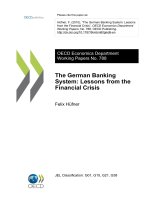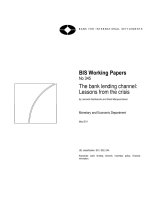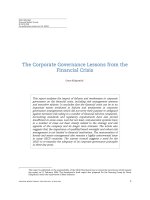moloney - how to protect investors; lessons from the ec and the uk (2010)
Bạn đang xem bản rút gọn của tài liệu. Xem và tải ngay bản đầy đủ của tài liệu tại đây (5 MB, 502 trang )
This page intentionally left blank
HOW TO PRO TE C T INVES TO RS
As governments around the world withdraw from welfare provision and
promote long-term savings by households through the financial markets,
the protection of retail investors has become critically important. Taking
as a case study the wide-ranging EC investor-protection regime which now
governs EC retail markets after an intense reform period, this critical, con-
textual and comparative examination of the nature of investor protection
explores why the retail investor should be protected, whether retail investor
engagement with the markets should be encouraged and how investor-
protection laws should be designed, particularly in light of the financial
crisis. The book considers the implications of the EC’s investor-protection
rules ‘on the books’ but also considers investor-protection law and policy
‘in action’, drawing on experience from the UK retail market and in par-
ticular the Financial Services Author ity’s extensive retail market activities,
including the recent Retail Distribution Review and the Treating Customers
Fairly strategy.
niamh moloney is a professor in the Law Department of the London
School of Economics and Political Science.
international corporate law and
financial market regulation
Recent years ha ve seen an upsurge of change and reform in corporate law and
financial market regulation internationally as the corporate and institutional
investor sector increasingly turns to the international financial markets. This
follows large-scale institutional and regulator y reform after a series of
international corporate governance and financial disclosure scandals exemplified
by the collapse of Enron in the US. There is now a great demand for analysis in
this area from the academic, practitioner, regulatory and policy sectors.
The International Corporate Law and Financial Market Regulation series will
respond to that demand by creating a critical mass of titles which will address the
need for information and high-qualit y analysis in this fast developing area.
Series Editors
Professor Eilis Ferran, University of Cambridge
Professor Niamh Moloney, London School of Economics and Political Science
Professor Howell Jackson, Harvard Law School
Editorial Board
Professor Marco Becht, Professor of Finance and Economics at Universit
´
e Libre
de Bruxelles and Executive Director of the European Corporate Governance
Institute (ECGI).
Professor Brian Cheffins, S. J. Berwin Professor of Corporate Law at the Faculty
of Law, University of Cambridge.
Professor Paul Davies, Cassel Professor of Commercial Law at the London
School of Economics and Political Science.
Professor Luca Enriques, Professor of Business Law in the Faculty of Law at the
University of Bologna.
Professor Guido Ferrarini, Professor of Law at the University of Genoa and
Honorary Professor, Faculty of Law, University College London.
Professor Jennifer Hill, Professor of Corporate Law at Sydney Law School.
Professor Klaus J. Hopt, Director of the Max Planck Institute of Comparative
and International Private Law, Hamburg.
Professor Hideki Kanda, Professor of Law at the University of Tokyo.
Professor Colin Mayer, Peter Moores Professor of Management Studies at the
Sa
¨
ıd Business School and Director of the Oxford Financial Research Centre.
James Palmer, Partner of Herbert Smith, London.
Professor Michel Tison, Professor at the Financial Law Institute of the University
of Ghent.
Andrew Whittaker, General Counsel to the Board at the UK Financial Services
Authority.
Professor Eddy Wymeersch, Chairman of the Committee of European Securities
Regulators (CESR); Co-Chair of the CESR-European Central Bank Working
Group on Clearing and Settlement, and part-time Professor of Commercial Law,
University of Ghent.
HOW TO PRO TE CT I NVES TORS
Lessons from the EC and the UK
NIA M H MOL ON E Y
CAMBRIDGE UNIVERSITY PRESS
Cambridge, New York, Melbourne, Madrid, Cape Town, Singapore,
São Paulo, Delhi, Dubai, Tokyo
Cambridge University Press
The Edinburgh Building, Cambridge CB2 8RU, UK
First published in print format
ISBN-13 978-0-521-88870-7
ISBN-13 978-0-511-67557-7
© Niamh Moloney 2010
2010
Information on this title: www.cambrid
g
e.or
g
/9780521888707
This publication is in copyright. Subject to statutory exception and to the
provision of relevant collective licensing agreements, no reproduction of any part
may take place without the written permission of Cambridge University Press.
Cambridge University Press has no responsibility for the persistence or accuracy
of urls for external or third-party internet websites referred to in this publication,
and does not guarantee that any content on such websites is, or will remain,
accurate or appropriate.
Published in the United States of America by Cambridge University Press, New York
www.cambridge.org
eBook
(
NetLibrar
y)
Hardback
To Iain
CONTENTS
Preface and acknowledgments page xiii
Ta b l e o f c a s e s xvii
Table of treaties and legislation xviii
List of abbreviations xxv
1 The retail investor and the EC 1
I. The importance of the retail markets 1
II. The retail markets and the EC 5
1. The development of a retail market agenda 5
2. Scope: the reach of EC investor protection law and policy 13
3. Beyond the cross-border context 18
4. But room for local ‘law on the books’ and for ‘law in action’: the
UK example 22
5. Examining retail investor protection through the EC lens 29
III. Who is the EC investor? 30
1. Characterizing the target of investor protection 30
2. The average EC investor: an elusive target? 31
3. Investors or consumers? 39
IV. The financial crisis and EC retail market policy 41
2 Designing a retail investor protection regime 45
I. Why intervene in the retail markets? Encouraging the empowered
investor, shielding the irrational investor or supporting the trusting
investor? 45
1. Characterizing investor protection 45
2. The retail investor as an agent of public policy and the
empowered investor 4 7
3. The irrational and uninformed investor 67
4. The trusting investor 81
II. The risks of retail market intervention 92
1. Regulatory and retail market agenda risks 92
vii
viii contents
2. Regulation and the retail markets: ‘laws on the books’ and ‘laws in
action’ 95
3. Responding to the drivers of retail market engagement 97
4. Centralization risks 100
III. How to intervene on the retail markets? 102
1. The regulatory toolbox and self-regulation 102
2. Achieving retail market outcomes 106
3. Principles-based regulation and the retail markets 108
4. Evidence-based policy formation and rule-making 114
5. Controlling risk-taking and segmentation techniques 118
6. Diversification 122
3 Product regulation 134
I. Product regulation and the retail markets 134
1. The EC and product regulation 134
2. The benefits of CIS product regulation 137
3. The risks of CIS product regulation 142
4. An integrated model 151
II. The UCITS investor protection regime and product regulation 152
1. Inbuilt diversification and liquidity 152
2. Inbuilt governance: the depositary and the management
company 153
III. The UCITS III product and design risks 157
1. The UCITS III regime 157
2. UCITS III and the risks of facilitative product design 162
3. Beyond UCITS III: alternative investments and product
design risks 168
4. Beyond product regulation: the product provider and the
provider/distributor relationship 176
IV. Structured and substitute products 179
1. The substitute product market and structured products 179
2. A segmented product regime and its risks 184
3. Developing a response 187
4 Investment advice and product distribution 192
I. Intermediation, its risks and regulation 192
1. The benefits of advice 192
2. The risks 193
3. Regulating advice 196
II. Scope of the advice and product distribution regime 200
1. The advice and distribution regime 200
2. MiFID’s scope: a wide range of instruments and services 202
contents ix
3. MiFID’s scope: the pivotal investment advice definition 203
4. MiFID’s scope: supporting access to advice? 204
5. MiFID’s scope: the nature of investor protection ‘on the books’ 207
III. Regulatory design choices 209
1. Regulatory design choice (1): maximum harmonization 209
2. Regulatory design choice (2): principles-based regulation 212
3. Regulatory design choice (3): shaping firm conduct and the
eclipsing of disclosure 213
IV. Regulatory technique (1): the fairness principle and ‘law in action’ 215
1. The fair treatment principle 215
2. The risks of ‘fairness’ 217
3. Fairness and the TCF model: ‘law in action’ 219
4. The implications of the TCF model 223
V. Regulatory technique (2): marketing risks 224
1. Marketing risks 224
2. Delivery-specific protection: online and distance contacts 226
3. Horizontal protection: consumer protection directives 227
4. Investment-specific protections: MiFID 231
VI. Regulator y technique (3): quality of advice and suitability 235
1. Suitability and objective advice 235
2. The suitability regime: suitability and appropriateness 237
3. Suitability ‘in action’ 240
VII. Regulatory technique (4): conflict-of-interest management 244
1. Conflict-of-interest risks 244
2. MiFID and retail market conflict-of-interest risk 245
VIII. Regulatory technique (5): the investment firm/investor contract 247
IX. Segmentation risks 250
1. The UCITS regime 250
2. Structured and substitute products 252
X. Advice or sales? Addressing the ‘right risks’ 256
1. Delivering high-quality investment advice 256
2. Incentive and commission risks: advice or sales? 257
3. MiFID and commission risk 263
XI. Fee-based investment advice: segmenting regulated advice 266
1. Delivering independent investment advice: the UK Retail
Distribution Review and other international experience 266
2. An EC model? 273
XII. Access to mass market advice and the sales problem 278
1. Access to advice 278
2. A mass market advice regime and MiFID: generic advice 279
3. Access to advice a nd the UK experience 279
4. The EC and access to advice 285
x contents
5 Disclosure 288
I. Disclosure and EC investor protection 288
1. The retail market disclosure regime 288
2. The investor understanding problem 290
3. The risks of disclosure 296
4. Disclosure ‘in action’ 300
II. Investment product disclosure (1): the UCITS regime 304
1. Designing CIS disclosure: the challenge 304
2. The EC laboratory 312
III. Investment product disclosure (2): the substitute products
challenge 322
1. A fragmented regime 322
2. Developing a response 330
IV. Disclosure in the distribution and advice context 333
1. Marketing communications 333
2. General investment firm and services disclosure: MiFID
Article 19(2) and (3) 334
3. Conflicts of interest and commissions 337
6 The trading process 345
I. Promoting access to trading 345
1. Better diversification and lower trading costs 345
2. The risks and execution-only services 350
II. Investor protection in the trading process 354
1. A matrix of rules 354
2. Best execution 355
3. Trading and issuer disclosure 363
7 Education and governance 374
I. Investor education 374
1. Investor education 374
2. Building an investor education strategy: the UK example 384
3. Investor education and EC retail market policy 389
II. Retail investor involvement in policy formation and law-making 398
1. Retail investor involvement 398
2. Retail governance and the EC 399
3. Improving investor governance 413
4. CESR and the retail markets 419
8 Supervision, enforcement and redress 426
I. Public supervision and enforcement in the retail markets 426
1. Public supervision and enforcement in the retail markets 426
contents xi
2. The EC regime 426
3. Risks to the retail markets 429
4. CESR, the retail markets and supervisory convergence 436
5. Investor compensation schemes 440
II. Investor redress 442
1. Access to justice and the retail investor 442
2. Direct retail investor action 444
3. Collective action 458
Index 464
PREFACE AND ACKNOWLEDGMENTS
This book is concerned with the protection of retail or household investors.
The retail markets can be something of a Cinderella in financial market
regulation. The regulatory challenges can be humdrum but intractable, the
retail constituency quiescent and unhelpful to the beleaguered regulator,
and the empirical and analytical pyrotechnics of law and finance and of
law and economics, typically applied to financial market regulation, often
overlook this area; behavioural finance is, however, now taking up some
of the empirical heavy lifting. But, as governments withdraw from welfare
provision and promote stronger long-term household saving, the retail
markets have become of central importance; to borrow a phrase from law
and finance, they ‘matter’. So does investor protection regulation and how
it is developed and designed.
This book accordingly addresses three questions. Who is the retail
investor (chapter 1)? Why should that investor be protected (chapter 2)?
How should protection be designed (chapters 3–8)? It considers whether
investors are best characterized as empowered, irrational or trusting, and
considers the implications for regulatory design. Its case study is the mas-
sive EC harmonized regulatory regime for Member States’ retail invest-
ment markets which provides a rich case study of investor protection law
‘on the books’. But effective retail market protection depends heavily on
‘law in action’, which remains largely the preserve of the Member States.
Thebook’smaincasestudyfordomestic‘lawinaction’istheUKand,in
particular, the retail market activities of the Financial Services Authority.
A note on the European terminology used is necessary. The book is
largely concerned with the internal market aspect of the European Union
and so generally refers to the European Community, the EC and the EC
Treaty. At the time of w riting, the Lisbon Treaty had not been ratified by all
the Member States. If the Treat y comes into force, the relevant EC Treaty
provisions will not change in substance, but will be incorporated into the
new Treaty on the Functioning of the European Union, and references to
xiii
xiv preface and acknowledgments
the EC or European Community in this book should be read as references
to the EU or European Union.
This book entered its final stages against the backdrop of the financial
crisis. In the maelstrom, as regulatory and governmental attention focused
on safety and stabilization, retail investor interests have been largely over-
shadowed. Household wealth has, however, been destroyed, investor trust
has been badly shaken and the policy drive to encourage stronger market-
based saving seems quixotic, at least at first glance. Nonetheless, as this
book argues, the difficult task of designing an effective investor protec-
tion system and of supporting household engagement with the markets
must go on. Much greater evidence is needed on how investors think
and behave (chapter 2). Hard questions concerning the degree to which
investors should be allowed to access more complex products must be
answered, particularly given the losses related to structured products over
the crisis (chapter 3). Disclosure, the great panacea of modern investor
protection, seems all the more a troublesome device (chapter 5). As dis-
cussed in chapter 7, the voice of the retail investor, however ill-informed
and erratic that voice may be, has been largely absent from the policy
debate on the crisis. This must change.
The book aims to state the law and major policy developments as at
31 May 2009 although it has been possible to make some very brief refer-
ences to subsequent major developments. A number of these are reveal-
ing as to the direction of the policy debate on retail investor protection.
Most notably, perhaps, the Obama Administration’s blueprint for regu-
latory reform (Department of the Treasury, Financial Regulatory Reform
(2009)), which took as a key objective the protection of consumers and
investors from financial abuse, includes significant institutional reform in
the form of a new Consumer Financial Protection Agency which will share
responsibility with the Securities and Exchange Commission for protect-
ing consumers of financial services. From an EC perspective, much can
be learned from the emphasis being placed on the Agency’s gathering of
‘actual data about how people make financial decisions’. Otherwise, there
is dishearteningly little evidence of any attempts to gather meaningful data
on how household investors reacted to the crisis; the European Commis-
sion’s 2009 Eurobarometer survey on the cri sis was limited to a survey
of reaction to the EU’s general efforts (Standard Eurobarometer (EB 71),
Europeans and the Economic Crisis (2009)).
Institutional reform has also been a major theme of the EC response
to the crisis, although here the retail interest was not the driving factor
(chapter 7). The Commission’s September 2009 proposals for a European
preface and acknowledgments xv
System of Financial Supervisors and, in particular, for a central European
Securities and Markets Authority (which followed the Commission’s May
2009 Communication on supervision and the agenda-setting de Larosi
`
ere
Report) promise much for better pan-EC prudential supervision. But the
impact on retail market law-making is not yet clear, although the pro-
posed Authority will have the power to adopt binding technical standards
(endorsed by the Commission). Some efforts are, however, being made
to engage the retail sector with the Authority’s work through enhanced
consultation procedures (via a Stakeholders Group). The proposed Joint
Committee of European Supervisory Authorities may also lead to better
cross-sectoral law-making, although institutional segmentation between
the banking, insurance/pensions and securities sectors persists in the new
model. The initial failure to engage with the retail sector during the impor-
tant de Larosi
`
ere discussions remains disheartening (chapter 7). The crisis
has, however, galvanized FIN-USE, the EC’s forum for the consumer inter-
est in financial services, to produce a number of papers, significant by their
very adoption, on the crisis (including FIN-USE, The Future of Financial
Services Supervision (2009)). Otherwise, and perhaps reassuringly given
persistent governance and evidence-gathering weaknesses, there was little
in the way of knee-jerk reaction, wi th the 2009 Commission Commu-
nication on the treatment of substitute investment products emerging
from a discussion which pre-dated the crisis, although the crisis may have
encouraged the Commission to adopt what is a relatively radical reform
agenda.
Similarly, in the UK, prudential and stability matters have been to the
fore, although the FSA did proceed with the next stage of its massive
Retail Distribution Review in June 2009, presenting specific reform pro-
posals designed to address persistent and entrenched conflicts of interest
in the commission-based UK investment advice and product distribution
industry (Consultation Paper 09/18). The proposals broadly reflect the
FSA’s final thinking on the Review in 2008 (chapter 4 ). Investment advice
concerning a broad range of substitute ‘retail investment products’ will be
segmented into ‘independent advice’ and ‘restricted adv ice’. ‘Independent
advice’ must be unbiased, unrestricted and based on a comprehensive
andfairanalysisoftherelevantinvestmentproductmarket.Advicemust
otherwise be labelled as ‘restricted’, including where a firm advises only
on proprietary products. A new adviser charging model will apply to all
investment advice; the current commission-based system will be prohib-
ited. A new professional standards regime for all investment advice will
also be adopted.
xvi preface and acknowledgments
Overall, however, there is little evidence of a policy concern, post-crisis,
to rethink howinvestor protection is delivered. The dominant assumptions
concerning investor empowerment, investor competence and theinvestor’s
carrying of market risk remain in place.
The completion of this book was supported by a Research Leave Award
from the Arts and Humanities Research Council which I very grate-
fully acknowledge. Cambridge University Press, in particular Kim Hughes
and Daniel Dunlavey, oversaw the book’s production with great cour-
tesy and efficiency. I would also like to thank the many people from
whose work I have learned; in particular, I owe a great deal to Profes-
sors Eil
´
ıs Ferran, Guido Ferrarini, Klaus Hopt, Howell Jackson, Donald
Langevoort, Stephen Weatherill and Eddy Wymeersch, whose scholarship
has inspired me.
My greatest inspiration is my wonderful husband, Iain. This book is
dedicated to him.
Niamh Moloney
1 October 2009
TABLE OF CASES
Alpine Investments BV v. Minister van Financi
¨
en [1995] ECR I-1141 (Case C-384/93)
91, 233
Antonio Testa and Lido Lazzeri v. Commissione Nazionale per la Societ
`
aelaBorsa
(Consob) [2002] ECR I-10797 (Case C-365/00) 17
Commission of the European Communities v. Federal Republic of Germany [1986]
ECR 3755 (Case 205/84) 91
Gut Springenheide GmbH and Rudolf Tusky v. Oberkreisdirektor des Kreises
Steinfurt – Amt f
¨
ur Lebensmittel
¨
uberwachung [1998] ECR I-4657 (Case C-210/96)
92, 115
Est
´
ee Lauder Cosmetics GmbH & Co. OHG v. Lancaster Group GmbH [2000] ECR
I-117 (Case C-220/98) 92
Soci
´
et
´
eCivileImmobili
`
ere Parodi v. Banque H. Albert de Bary et Cie [1997] ECR
I-3899 (Case C-222/95) 91
Verein gegen Unwesen in Handel und Gewerbe K
¨
oln eV v. Mars GmbH [1995] ECR
I-1923 (Case C-470/93) 446
xvii
TABLE OF TREATIES AND LEGISLATION
EC Treaty and EC legislation
EC Treaty
Art.3 5
Art.5 10
Art. 10 . . . 446
Art. 14 . . . 5
Art. 43 . . . 5
Art. 44(2)(g) . . . 10
Art. 47(2) . . . 10
Art. 49 . . . 5
Art. 55 . . . 10
Art. 56 . . . 5
Art. 94 . . . 10
Art. 95 . . . 10
Art. 153(1) . . . 391
Art. 251 . . . 405
Art. 257 . . . 405
Consolidated Life Assurance Directive 2002/83/EC . . . 323
Deposit Guarantee Directive 1994/19/EC . . . 42, 442
Distance Marketing of Financial Services Directive 2002/65/EC . . . 8, 14, 21, 40, 57,
201, 226, 228, 233, 249, 255, 289
Art. 3(1) . . . 450
Art. 3(4) . . . 450
Art. 12 . . . 209
Art. 13 . . . 459
Art. 14 . . . 454
Art. 15 . . . 445
E-Commerce Directive 2000/31/EC . . . 7, 227, 334
Injunctions in the Consumer Interest Directive 1998/27/EC . . . 459, 460
xviii
table of treaties and legislation xix
Art.2 459
Art.4 459
Art.5 459
Insurance Mediation Directive 2002/92/EC . . . 16, 201, 236, 253, 255, 276, 339
Art. 12(1) . . . 253, 339
Art. 12(2) . . . 254
Art. 12(3) . . . 254
Investment Services Directive 1993/22/EC . . . 7, 203
Investor Compensation Schemes Directive 1997/9/EC . . . 42, 63, 441, 442
Legal Aid Directive 2002/8/EC . . . 447
Market Abuse Directive 2003/6/EC . . . 364, 366, 369, 403
Art.6 364
Art. 6(3) . . . 364
Markets in Financial Instruments Directive (MiFID) 2004/39/EC . . . 10, 13, 14, 15,
17, 19, 22, 24, 25, 27, 52, 57, 89, 102, 106, 110, 111, 112, 113, 114, 126, 130, 132, 133,
151, 186, 190, 195, 199, 200, 201, 202, 203, 204, 207, 209, 213, 223, 233, 236, 241, 252,
253, 254, 255, 256, 263, 265, 272, 286, 288, 293, 295, 315, 346, 357, 388, 389, 409, 419,
445, 450
Art.1 13
Art. 2(1)(c) . . . 203
Art. 2(1)(h) . . . 201
Art. 2(1)(j) . . . 203
Art. 2(2) . . . 441
Art.3 206, 275, 286
Art. 3(2) . . . 335
Art. 4(1)(4) . . . 203
Art.5 13
Art. 5(5) . . . 276
Art.6 207
Art.7 207, 276
Art. 7(2) . . . 207
Art. 11 . . . 207
Art. 12 . . . 207
Art. 13 . . . 348
Art. 13(3) . . . 245
Art. 13(7) . . . 207
xx table of treaties and legislation
Art. 13(8) . . . 207
Art. 18 . . . 245, 348, 353
Art. 18(1) . . . 245
Art. 18(2) . . . 245, 338
Art. 19 . . . 207, 209, 348
Art. 19(1) . . . 115, 213, 215, 216, 217, 220, 221, 230, 234, 236, 240, 245, 249, 263,
264, 354, 359
Art. 19(2) . . . 115, 213, 215, 230, 231, 233, 234, 254, 324, 326, 327, 335, 339, 341,
342
Art. 19(3) . . . 215, 230, 324, 325, 326, 334, 335, 339, 341, 342, 357
Art. 19(4) . . . 215, 237
Art. 19(5) . . . 127, 215, 237, 239
Art. 19(6) . . . 120, 126, 128, 215, 353
Art. 19(7) . . . 215, 249
Art. 19(8) . . . 215, 336
Art. 21 . . . 348, 355
Art. 21(1) . . . 356
Art. 21(2) . . . 356
Art. 21(3) . . . 356, 359
Art. 22(1) . . . 215
Art. 22(2) . . . 349
Art. 27 . . . 349
Art. 32(7) . . . 427, 435
Art. 48 . . . 428
Art. 50 . . . 428
Art. 51 . . . 429
Art. 52 . . . 459
Art. 53 . . . 454
Art. 56 . . . 428
Art. 57 . . . 428
Art. 58 . . . 428
Art. 59 . . . 428
Art. 62 . . . 427
MiFID Level 2 Directive 2006/73 . . . 15, 17, 200, 203, 207, 209, 215, 238, 245, 263, 315
Art.4 102, 210, 211, 247, 273, 278, 328, 329
Art. 4(1) . . . 15, 203
Art.5 207
Art.6 207
Art.7 207
Art.8 207
table of treaties and legislation xxi
Art.9 207
Art. 10 . . . 207, 447
Art. 11 . . . 207
Art. 12 . . . 207
Art. 13 . . . 207, 348
Art. 14 . . . 207
Art. 15 . . . 207
Art. 16 . . . 207
Art. 17 . . . 207
Art. 18 . . . 207
Art. 19 . . . 207
Art. 20 . . . 207
Art. 21 . . . 263
Art. 22 . . . 263, 264
Art. 22(4) . . . 338
Art. 23(3) . . . 338
Art. 26 . . . 216, 264, 334
Art. 26(b) . . . 342
Art. 27 . . . 216, 231
Art. 27(2) . . . 231, 232
Art. 27(3) . . . 232, 325
Art. 27(4) . . . 232, 325
Art. 27(5) . . . 232, 325
Art. 27(6) . . . 232, 325
Art. 27(7) . . . 232
Art. 27(9) . . . 232
Art. 29 . . . 334
Art. 29(1) . . . 335
Art. 29(2) . . . 335
Art. 29(4) . . . 325, 335
Art. 29(8) . . . 232
Art. 30 . . . 334, 336, 338
Art. 30(1)(h) . . . 340
Art. 30(2) . . . 336
Art. 30(3) . . . 336
Art. 31 . . . 216, 334, 336
Art. 31(1) . . . 325
Art. 31(2) . . . 325
Art. 31(5) . . . 326
Art. 32 . . . 334, 336
Art. 33 . . . 326, 334, 340
Art. 34 . . . 216, 334
xxii table of treaties and legislation
Art. 35(1) . . . 219
Art. 35(5) . . . 238
Art. 38 . . . 126
Art. 38(d) . . . 289
Art. 41 . . . 336
Art. 42 . . . 336
Art. 43 . . . 336
Art. 44(1) . . . 356
Art. 44(3) . . . 357
Art. 44(4) . . . 357
Art. 46(2) . . . 359
Art. 51 . . . 207
Art. 52 . . . 203
Prospectus Directive 2003/71/EC . . . 9, 13, 52, 119, 120, 129, 289, 323, 363, 366,
369, 444
Art. 5(1) . . . 370
Art. 5(2) . . . 445
Art.6 364
Art. 6(1) . . . 444
Art. 6(2) . . . 444
Art. 13 . . . 324
Art. 14 . . . 324
Art. 14(2) . . . 366
Art. 19 . . . 370
Prospectus Regulation 2004/809
Art. 24 . . . 370
Transparency Directive 2004/109/EC . . . 13, 364, 366, 369, 444
Art.4 364
Art.5 364
Art.6 364
Art.9 364
Art. 10 . . . 364
Art. 11 . . . 364
Art. 12 . . . 364
Art. 13 . . . 364
Art. 14 . . . 364
table of treaties and legislation xxiii
Art. 15 . . . 364
Art. 16 . . . 364
Art. 20 . . . 369
Art. 21 . . . 367
Art. 22 . . . 367
Undertakings for Collective Investment in Transferable Securities (UCITS) Directive
1985/611/EC . . . 7, 26, 121, 122, 126, 128, 134, 135, 142, 146, 149, 151, 152, 153,
156, 162, 163, 168, 176, 188, 189, 246, 250, 295, 302, 321
Art.1 13
Art. 1(1) . . . 152
Art. 1(2) . . . 158
Art. 1(3) . . . 153
Art.4 152
Art. 4(2) . . . 154
Art. 4(3) . . . 155
Art.5 156
Art. 19 . . . 158
Art. 19(6) . . . 166, 167
Art. 27(1) . . . 313
Art. 28 . . . 313
Art. 28(1) . . . 314
Art. 28(2) . . . 313
Art. 28(3) . . . 312, 314
Art. 32 . . . 313
Art. 33 . . . 313
Art. 37(1) . . . 152
Art. 42 . . . 159
Art. 44 . . . 250, 426
Art. 44(2) . . . 250
Art. 47 . . . 313
Art. 49 . . . 428
Art. 52 . . . 427
Art. 77 . . . 251
Art. 79 . . . 445
Art. 91 . . . 427
Art. 97 . . . 427, 428
Art. 98 . . . 428
Art. 99 . . . 429
Art. 108 . . . 427
Sched. A . . . 313









